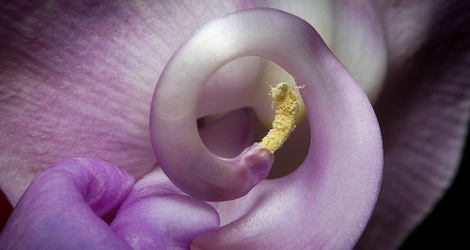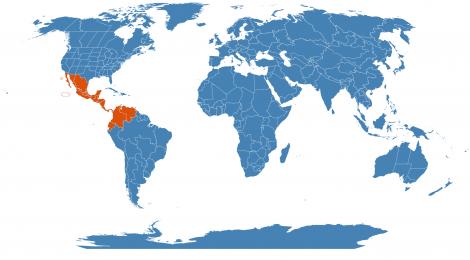Accession Data:
Sigmoidotropis speciosa (Kunth) A. Delgado
- Common Name: Wandering Cowpea
- Family: Fabaceae Juss.
- Synonym(s): Vigna speciosa
- Description: Unique purple flowers produce copious nectar, which is attractive to small species of bees. Visiting bees must push their way between the petals to attain this reward. As the keel petal is pushed down, the stigma and stamens emerge from the tip of the keel enforcing the transfer of pollen between flower and insect.
- USDA Zone: 9-10
Accession Data:
- Accession # 199500103
- Source: Unknown
- Provenance: Plant previously labelled Clitoria terneata, but determined to be an incorrect ID - not sure what it is at this point, but very interesting morphology with enclosed stamens emerging from tube when petals separated as might occur if a larger insect / small bird were to perch on petals.
Inspection of photos by Paul Franz at NC State suggest this is definitely not a Clitoria, but a member of the Phaseolus-Macroptilium complex. For the time being we will list it as Phaseolus sp.
05NOV04 - name changed to Vigna caracalla after seeing same plant labelled as such at Mt Holyoke Botanic Garden - cmorse - Accession Date: 03-15-1995
- Bench: 1320 - NEOA: West Bench SS
- Currently: active - healthy
- Qty: 2 confirmed on 02-27-2021
Classification:
- Division: Magnoliophyta
- Class: Magnoliopsida
- SubClass: eurosid I
- Order: Fabales
- SubOrder:
- Family: Fabaceae
- SubFamily: Faboideae
- Tribe: Phaseoleae
- SubTribe: Phaseolinae
Flowering Data:
This accession has been observed in bloom on:| Year | Jan | Feb | Mar | Apr | May | Jun | Jul | Aug | Sep | Oct | Nov | Dec | ||||||||||||||||||||||||||||||||||||||||
|---|---|---|---|---|---|---|---|---|---|---|---|---|---|---|---|---|---|---|---|---|---|---|---|---|---|---|---|---|---|---|---|---|---|---|---|---|---|---|---|---|---|---|---|---|---|---|---|---|---|---|---|---|
| 2021 | ||||||||||||||||||||||||||||||||||||||||||||||||||||
| 2020 | ||||||||||||||||||||||||||||||||||||||||||||||||||||
| 2019 | ||||||||||||||||||||||||||||||||||||||||||||||||||||
| 2018 | ||||||||||||||||||||||||||||||||||||||||||||||||||||
| 2017 | ||||||||||||||||||||||||||||||||||||||||||||||||||||
| 2016 | ||||||||||||||||||||||||||||||||||||||||||||||||||||
| 2015 | ||||||||||||||||||||||||||||||||||||||||||||||||||||
| 2014 | ||||||||||||||||||||||||||||||||||||||||||||||||||||
| 2013 | ||||||||||||||||||||||||||||||||||||||||||||||||||||
| 2012 | ||||||||||||||||||||||||||||||||||||||||||||||||||||
| 2011 | ||||||||||||||||||||||||||||||||||||||||||||||||||||
| 2010 | ||||||||||||||||||||||||||||||||||||||||||||||||||||
| 2009 | ||||||||||||||||||||||||||||||||||||||||||||||||||||
| 2008 | ||||||||||||||||||||||||||||||||||||||||||||||||||||
| 2007 | ||||||||||||||||||||||||||||||||||||||||||||||||||||
| 2006 | ||||||||||||||||||||||||||||||||||||||||||||||||||||
| 2005 | ||||||||||||||||||||||||||||||||||||||||||||||||||||
References (internal):
- EEB 3271 - Systematic Botany
- EEB 3203 - Developmental Plant Morphology
- AntU - Learning from the Complex Society of Army Ants & Their Guests
- Bee Pollination (melittophily)
- Pollination Syndrome Scavenger Hunt
- ECE 2019 - Scavenger Hunt
- EEB Greenhouse Holdings native to: Mexico Central / Mexico Northeast / Mexico Gulf / Mexican Pacific Is. / Mexico Northwest / Mexico Southwest / Mexico Southeast / Belize / Costa Rica / El Salvador / Guatemala / Honduras / Nicaragua / Panama / Venezuela / Colombia / Ecuador
References (external):
- The Plant List (2013). Version 1.1. Last accessed on Thursday, February 08, 2018.
- Sigmoidotropis speciosa at ARS-GRIN. Last accessed on Thursday, February 08, 2018.
data regenerated on Thu, 13 May 2021 10:31:12 -0400 [bcm v4.0]
Images:

Additional images for this accession:
Click on thumbnails to enlargeCurrent Accessions in the Fabaceae
Subfamily Caesalpinioideae
Tribe Cassieae
- Cassiinae: Cassia fistula

- Cassiinae: Senna corymbosa

- Ceratoniinae: Ceratonia oreothauma W/C

- Ceratoniinae: Ceratonia siliqua


Subfamily Caesalpinioideae
Tribe Detarieae
Subfamily Faboideae
Tribe Amorpheae
Subfamily Faboideae
Tribe Dalbergieae
Subfamily Faboideae
Tribe Desmodieae
- Desmodiinae: Codariocalyx motorius


Subfamily Faboideae
Tribe Galegeae
Subfamily Faboideae
Tribe Genisteae
Subfamily Faboideae
Tribe Millettieae
Subfamily Faboideae
Tribe Mirbelieae
Subfamily Faboideae
Tribe Phaseoleae
- Cajaninae: Rhynchosia phaseoloides


- Clitoriinae: Clitoria ternatea

- Erythrininae: Apios americana

- Erythrininae: Erythrina crista-galli

- Phaseolinae: Sigmoidotropis speciosa


Subfamily Faboideae
Tribe Podalyrieae
Subfamily Faboideae
Tribe Sophoreae
Subfamily Mimosoideae
Tribe Acacieae
- Acacia angustissima

- Acacia brachybotrya

- Acacia longifolia subsp. sophorae

- Acacia saligna


- Vachellia cornigera


- Vachellia farnesiana


- Vachellia hindsii


Subfamily Mimosoideae
Tribe Ingeae
Subfamily Mimosoideae
Tribe Mimoseae
W/C = Wild Collected
 = indicates flowering in past 14 days
= indicates flowering in past 14 days
 = images available for this accession
= images available for this accession
 = map available for this accession
= map available for this accession
 = accession added within past 90 days
= accession added within past 90 days


